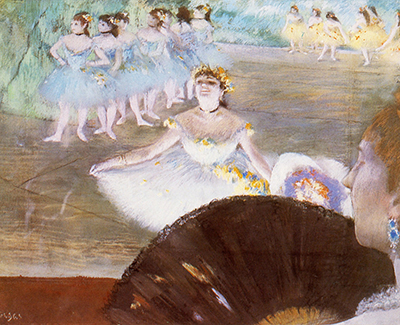The stunning pastel piece dates to 1878 near the later part of the artist's career.
This artwork illustrates a young ballerina looking into the audience with her head held high. The emotion behind the artwork significantly resembles remarkable elements from the artist's colleagues Pierre-Auguste Renoir and Claude Monet. All three artists are known as the forefathers of impressionistic art, whether they understood their significance at the time, or not. The focal point of the painting falls back onto the ballerina near the centre of the frame. However, there is a multitude of emotion and events occurring within the painting that the viewer is guaranteed to wonder through the rest of the painting. The ballerina gently lifts her head up high towards the crowd as she smiles with her white teeth showing. Her pale skin is illuminated by a light source shining onto the stage. Degas added some shade onto her skin in order to create contrast and add a glimpse of contour. The woman's brown eyes look gently onto the audience with glimpses of her chestnut hair. A bright pastel yellow coloured flower crown hugs the perimeter of the woman's head in grace. A small dark necklace gently hugs her neck as an accessory varying from the rest of her attire.
The woman is dressed in a bright white dress that falls off of her shoulders exposing her chest and arms. The woman's skirt bursts out open towards the floor. The yellow flowers found in the woman's hair travel throughout her dress in small specs. As evident through the title, the ballerina is holding a bouquet of bright yellow and blue flowers in her hand. She gently holds the edges of her skirt as she pliŽs towards the audience. Near the left of the painting, an array of girls dressed in blue gowns perform their dance. These seven girls stand in a linear line behind their leader as they prepare to perform. Their hands are gently placed above their hips as they push their chest outwards. Their pastel blue dresses stunningly contrast with their pale skin. They each have a tangerine coloured flower holding the bun on their hair together.
Near the back right of the pastel piece, another group of ballerinas fill the scene. These women are dressed in pastel yellow coloured costumes with bright orange flowers in their hair. It's difficult to truly witness the detailing of their costumes. However, small orange flowers are gently placed throughout their costume. Degas sticks to a light colour scheme steering away from pigment rich shades. He uses a light brown to paint the wooden floor boards with hints of lilac and yellow throughout. Near the left of the painting, mint green trees fill the stage. Additional colouring is placed on the back-centre wall in similar mint and blue shades.
The other stunning aspect of the artwork are the woman in the audience watching the performance. She is seated in the first row near the right of the stage and looks onto the ballerina accepting the bouquet. This woman has bright orange hair and immensely pale skin. A bright blue earring hangs on her ear with a silver lining. The woman holds onto a grand brown fan. This fan covers a portion of the stage, and the ballerina's costume. This is a significant element to add into the artwork as Degas veers away from solely depicting ballerinas and instead adds a different aspect for his work. We're able to witness what the show looks like as if we were seated members in the audience.




